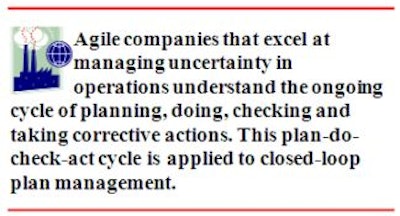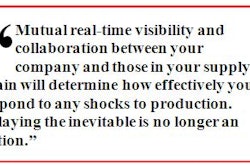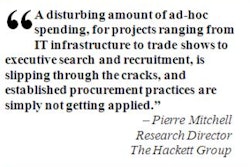
May 7, 2009 — Most global companies today manage a complex network of sales and marketing teams that reflect their segmented business models. A typical organization has enterprise customers, public sector accounts, inside sales, e-commerce sales, regional sales in global geographies, partnerships with distributors in support of regional strategies, partnerships with retailers for consumer sales, and value-added reseller (VAR) networks that help target micro-segmented markets with specific offerings. This means revenue and product forecasts must reflect the micro-segmented focuses and be an exercise of predicting future behavior within each market sub-segment and its associated customers or partners. However, the uncertainty in such behavior often leads to large variances in demand forecasts at a detailed level. As a result, the confidence in product demand beyond the immediate backlog and proximate pipeline is lower than ever before.
In addition, uncertainty in demand forecasting is compounded by the complexity of global outsourced supply networks. Increased cost pressures and specialization have led to the globalization of procurement and outsourcing of manufacturing to low-cost countries. The resultant supply network, which includes original design manufacturers, contract manufacturers and multiple tiers of component suppliers, tends to be cumbersome. Component suppliers and manufacturing facilities are often so geographically removed from the markets and inventory storages that end-to-end product lead times have become longer. This has a direct impact on operations managers, who have to predict the future demand mix beyond backlog and a high-confidence pipeline, which is a daunting task.
The following examples characterize challenges in the demand planning landscape:
Example #1: Large-volume Orders
A large computer manufacturer is organized regionally to support demand planning and order fulfillment for multiple channels, including enterprise accounts, distributors, VARs and small and midsize businesses (SMB). The demand forecast for each market segment and region is developed first at a product family level and then disaggregated to a component level based on historical trends. Each region sends its component-level aggregate demand to a global procurement group that creates a global supply plan for subassemblies and components.
Although the supply plan assumes a somewhat linear flow of demand, the enterprise sales teams may develop opportunities tied to customer initiatives that typically lead to large-volume orders of certain products. These orders become a problem for order fulfillment groups to track and manage as they cause disruptions by consuming a significant percentage of overall available supply. To tackle the problem, the order fulfillment group will develop a separate process-based spreadsheet to continuously reevaluate potential deals that can come to fruition three to 12 weeks out in order to detect issues in a timeframe in which proactive correction of supply is feasible.
Successful demand management in this case requires the ability to detect significant events for each deal in the pipeline and update the probability of closing, the potential product mix and the shipment timeline. Also, the collaborative processes among sales, order fulfillment and global procurement teams are essential to updating demand signals and taking proactive actions on supply.
Example #2: Planning Synchronization
At a semiconductor manufacturer, the corporate planning group coordinates between demand planners in sales and marketing and the site planners on the supply side, such as manufacturing locations and subcontractors. The sales and marketing professionals have to come up with a demand projection for the current and next quarters, while supply planners expect them to provide a single forecasted demand number — at product mix level by week or month — and an upside number. With this information, the corporate planning group will create and publish, in collaboration with site planners at manufacturing facilities, a capacity plan for the quarter and a master schedule for the production of various products.
The capacity plan and master schedule, however, are based on simplified approximations and therefore can misrepresent reality and cause individual sites to modify the plan.
Furthermore, site planners tend to make significant changes to the supply plan, such as offloading some starts to subcontractors based on prior agreements, holding back or pushing through certain demands at a higher priority because they have a different view of cycle times or yields than the corporate planners, and making other changes that may have nothing to do with optimization logic. These downstream changes are not synchronized with the published plan of record. Therefore, when new demand information flows in and the supply chain organization reevaluates the demand-supply picture, the lack of synchronization will lead to a mismatch between planned and actual work-in-process, as well as inventory. Tracking what changed and why becomes a grueling daily exercise. Incremental re-planning based on changed demand grows into such a complicated problem that it is shelved until the next complete re-plan can take place.
Example #3: Point-of-sale Data
A major consumer electronics OEM obtains point-of-sale (POS) data from its top retail partners. While the data are available at the store level, the OEM typically aggregates them to the national level for analysis. The aggregated data are used to create a rolling forecast that is used by manufacturing and also by the retailer's account teams in weekly collaborative planning, forecasting and replenishment (CPFR) calls with their buyers.
In this case, inventory and sell-through data viewed at a finer level of granularity tell a different story. At the regional distribution centers, for example, inventory availability deviates quite often from the established target weeks of supply. Because the magnitude of these regional variations is often obscured at the aggregate level, a drop in sell-through may go undetected for a few weeks. The resulting inaccuracy and delay will cause revenue loss through either excess inventory or stock-out in stores.
Managing Uncertainty in Operations
As illustrated in the above scenarios, plan management and execution processes are exercises of change control. It is important to invest in processes, technologies and policies that help create a measure of certainty. It's just as important to develop processes, technologies and policies that allow supply chains to react to change swiftly when reality deviates from the assumptions on which a plan is created. The governing philosophy is best captured by the phrases "performance-to-plan" and "refine-to-plan." In other words, businesses must know how to take actions to modify the plan as soon as threats to it are detected so that the execution can be followed through and expected outcome can be delivered. This philosophy also helps create accountability for demand planning so companies won't treat it as just numbers and guesswork, but as a range of possible decisions made by individuals — customers, partners and suppliers — with degrees of probability.
Agile companies that excel at managing uncertainty in operations understand the ongoing cycle of planning, doing, checking and taking corrective actions. This plan-do-check-act cycle is applied to closed-loop plan management. A cornerstone of agility, effective closed-loop plan management is made up of the following capabilities:
Rapid planning: A supply plan will propagate decisions that impact supply six to 12 weeks in the future, so modifications to the decisions are required as new information comes to light. Companies that excel at plan management have the ability to use the latest information on constraints in the planning process and take into consideration multiple alternatives to arrive at realistic, optimal plans — fast. A reasonable rule of thumb is to create a plan in one-tenth of the time it will take to execute it (e.g., a 30-day plan should take no more that three days to create, review and roll out).
Proactive monitoring and analysis of threats: Once a plan is rolled out, it is subject to changes that are both expected and unexpected. Proactive monitoring requires using leading indicators of demand to understand trends, market position, competitor actions and levers available to influence future demand. For example, if the plan was to sell 300 units for the month at a rate of 10 per day, it's useful to check point-of-sale data to see if the expected sales are occurring. If five units were sold on the first day, it's helpful to understand the root causes of the shortfall in order to take appropriate actions. The corrective actions are different for a sales decline caused by supply issues than one caused by a competitor's price discounts. Understanding root causes for demand fluctuations means understanding and incorporating market trends and customer behavior in the planning process.
Synchronized corrective actions: Plan owners are expected to take quick corrective action to ensure that their commitment to the synchronized plan holds even as the demand-supply assumptions on which the plan was based change. Preferred actions are those that can be taken unilaterally: for example, sales teams take pricing and promotion actions to reverse sales shortfalls. Such actions reduce variability for the rest of the business. But if a certain number of units must all take actions to modify the plan, it's important to collaborate and communicate quickly with all involved parties. Therefore, businesses must build trusted relationships with suppliers by sharing information that affects the supplier and demanding reciprocity in receiving early warnings.
Post-mortems and performance management: A rigorous post-mortem in each plan period helps companies understand the root causes of deviations and the reasons for corrective actions. It helps improve the planning process, holds teams accountable for execution and shifts the emphasis from playing the blame game to inductive learning.
So now what?
There are a number of key enterprise application capabilities companies should seek to enable closed-loop plan management. These include:
All these capabilities call for a more dynamic iterative planning platform in which planning, analytics and performance management are unified into an integrated enterprise planning solution.
About the Authors: Raj Devarajan is a client business manager in the High Tech Industry Group at i2 Technologies and works closely with high-tech customers to design solutions that address their specific supply chain problems. Anand Iyer is an i2 Fellow and vice president at i2 Technologies, with responsibility for overseeing i2's global process consulting practice. He's worked with several Fortune 500 companies as they sought to transform their business and supply chains. He's also the author of several articles and papers in peer-reviewed journals and holds several patents in the supply chain management domain. More information on i2 is available at www.i2.com.
In addition, uncertainty in demand forecasting is compounded by the complexity of global outsourced supply networks. Increased cost pressures and specialization have led to the globalization of procurement and outsourcing of manufacturing to low-cost countries. The resultant supply network, which includes original design manufacturers, contract manufacturers and multiple tiers of component suppliers, tends to be cumbersome. Component suppliers and manufacturing facilities are often so geographically removed from the markets and inventory storages that end-to-end product lead times have become longer. This has a direct impact on operations managers, who have to predict the future demand mix beyond backlog and a high-confidence pipeline, which is a daunting task.
The following examples characterize challenges in the demand planning landscape:
Example #1: Large-volume Orders
A large computer manufacturer is organized regionally to support demand planning and order fulfillment for multiple channels, including enterprise accounts, distributors, VARs and small and midsize businesses (SMB). The demand forecast for each market segment and region is developed first at a product family level and then disaggregated to a component level based on historical trends. Each region sends its component-level aggregate demand to a global procurement group that creates a global supply plan for subassemblies and components.
Although the supply plan assumes a somewhat linear flow of demand, the enterprise sales teams may develop opportunities tied to customer initiatives that typically lead to large-volume orders of certain products. These orders become a problem for order fulfillment groups to track and manage as they cause disruptions by consuming a significant percentage of overall available supply. To tackle the problem, the order fulfillment group will develop a separate process-based spreadsheet to continuously reevaluate potential deals that can come to fruition three to 12 weeks out in order to detect issues in a timeframe in which proactive correction of supply is feasible.
Successful demand management in this case requires the ability to detect significant events for each deal in the pipeline and update the probability of closing, the potential product mix and the shipment timeline. Also, the collaborative processes among sales, order fulfillment and global procurement teams are essential to updating demand signals and taking proactive actions on supply.
Example #2: Planning Synchronization
At a semiconductor manufacturer, the corporate planning group coordinates between demand planners in sales and marketing and the site planners on the supply side, such as manufacturing locations and subcontractors. The sales and marketing professionals have to come up with a demand projection for the current and next quarters, while supply planners expect them to provide a single forecasted demand number — at product mix level by week or month — and an upside number. With this information, the corporate planning group will create and publish, in collaboration with site planners at manufacturing facilities, a capacity plan for the quarter and a master schedule for the production of various products.
The capacity plan and master schedule, however, are based on simplified approximations and therefore can misrepresent reality and cause individual sites to modify the plan.
Furthermore, site planners tend to make significant changes to the supply plan, such as offloading some starts to subcontractors based on prior agreements, holding back or pushing through certain demands at a higher priority because they have a different view of cycle times or yields than the corporate planners, and making other changes that may have nothing to do with optimization logic. These downstream changes are not synchronized with the published plan of record. Therefore, when new demand information flows in and the supply chain organization reevaluates the demand-supply picture, the lack of synchronization will lead to a mismatch between planned and actual work-in-process, as well as inventory. Tracking what changed and why becomes a grueling daily exercise. Incremental re-planning based on changed demand grows into such a complicated problem that it is shelved until the next complete re-plan can take place.
Example #3: Point-of-sale Data
A major consumer electronics OEM obtains point-of-sale (POS) data from its top retail partners. While the data are available at the store level, the OEM typically aggregates them to the national level for analysis. The aggregated data are used to create a rolling forecast that is used by manufacturing and also by the retailer's account teams in weekly collaborative planning, forecasting and replenishment (CPFR) calls with their buyers.
In this case, inventory and sell-through data viewed at a finer level of granularity tell a different story. At the regional distribution centers, for example, inventory availability deviates quite often from the established target weeks of supply. Because the magnitude of these regional variations is often obscured at the aggregate level, a drop in sell-through may go undetected for a few weeks. The resulting inaccuracy and delay will cause revenue loss through either excess inventory or stock-out in stores.
Managing Uncertainty in Operations
As illustrated in the above scenarios, plan management and execution processes are exercises of change control. It is important to invest in processes, technologies and policies that help create a measure of certainty. It's just as important to develop processes, technologies and policies that allow supply chains to react to change swiftly when reality deviates from the assumptions on which a plan is created. The governing philosophy is best captured by the phrases "performance-to-plan" and "refine-to-plan." In other words, businesses must know how to take actions to modify the plan as soon as threats to it are detected so that the execution can be followed through and expected outcome can be delivered. This philosophy also helps create accountability for demand planning so companies won't treat it as just numbers and guesswork, but as a range of possible decisions made by individuals — customers, partners and suppliers — with degrees of probability.
Agile companies that excel at managing uncertainty in operations understand the ongoing cycle of planning, doing, checking and taking corrective actions. This plan-do-check-act cycle is applied to closed-loop plan management. A cornerstone of agility, effective closed-loop plan management is made up of the following capabilities:
Rapid planning: A supply plan will propagate decisions that impact supply six to 12 weeks in the future, so modifications to the decisions are required as new information comes to light. Companies that excel at plan management have the ability to use the latest information on constraints in the planning process and take into consideration multiple alternatives to arrive at realistic, optimal plans — fast. A reasonable rule of thumb is to create a plan in one-tenth of the time it will take to execute it (e.g., a 30-day plan should take no more that three days to create, review and roll out).
Proactive monitoring and analysis of threats: Once a plan is rolled out, it is subject to changes that are both expected and unexpected. Proactive monitoring requires using leading indicators of demand to understand trends, market position, competitor actions and levers available to influence future demand. For example, if the plan was to sell 300 units for the month at a rate of 10 per day, it's useful to check point-of-sale data to see if the expected sales are occurring. If five units were sold on the first day, it's helpful to understand the root causes of the shortfall in order to take appropriate actions. The corrective actions are different for a sales decline caused by supply issues than one caused by a competitor's price discounts. Understanding root causes for demand fluctuations means understanding and incorporating market trends and customer behavior in the planning process.
Synchronized corrective actions: Plan owners are expected to take quick corrective action to ensure that their commitment to the synchronized plan holds even as the demand-supply assumptions on which the plan was based change. Preferred actions are those that can be taken unilaterally: for example, sales teams take pricing and promotion actions to reverse sales shortfalls. Such actions reduce variability for the rest of the business. But if a certain number of units must all take actions to modify the plan, it's important to collaborate and communicate quickly with all involved parties. Therefore, businesses must build trusted relationships with suppliers by sharing information that affects the supplier and demanding reciprocity in receiving early warnings.
Post-mortems and performance management: A rigorous post-mortem in each plan period helps companies understand the root causes of deviations and the reasons for corrective actions. It helps improve the planning process, holds teams accountable for execution and shifts the emphasis from playing the blame game to inductive learning.
So now what?
There are a number of key enterprise application capabilities companies should seek to enable closed-loop plan management. These include:
- An agile data architecture that supports segmented planning models and rapid planning;
- Structured analytical workflows that can be used to evaluate deviations from plan and infer the impact on future outcomes;
- Plan management solutions that enable synchronization of updates into the plan of record;
- Planning algorithms that infer changes to strategies, policies and planning parameters based on analysis of current state and a user defined rules.
All these capabilities call for a more dynamic iterative planning platform in which planning, analytics and performance management are unified into an integrated enterprise planning solution.
About the Authors: Raj Devarajan is a client business manager in the High Tech Industry Group at i2 Technologies and works closely with high-tech customers to design solutions that address their specific supply chain problems. Anand Iyer is an i2 Fellow and vice president at i2 Technologies, with responsibility for overseeing i2's global process consulting practice. He's worked with several Fortune 500 companies as they sought to transform their business and supply chains. He's also the author of several articles and papers in peer-reviewed journals and holds several patents in the supply chain management domain. More information on i2 is available at www.i2.com.











